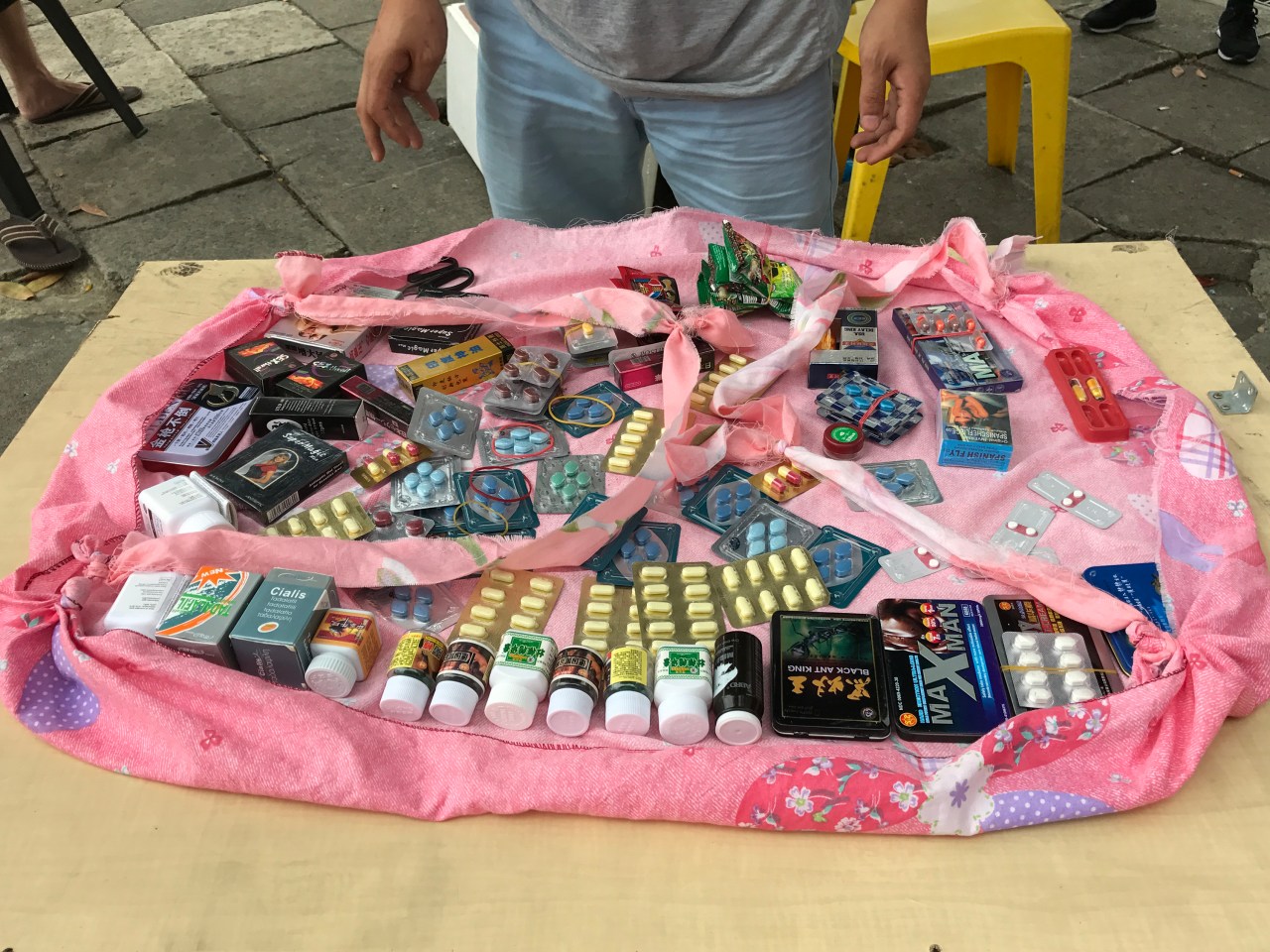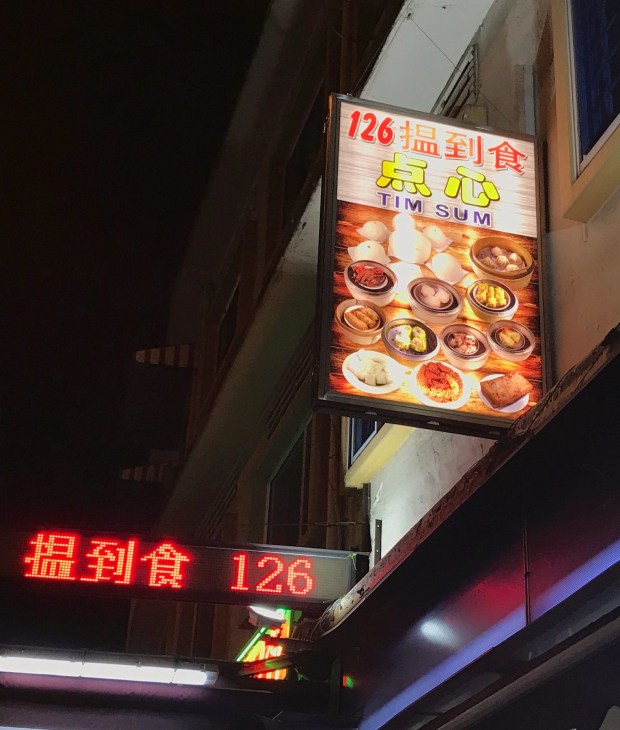In Singapore, in a plaza at the intersection of Geylang Road and Aljunied, life putters along easily one Sunday afternoon. Women in headscarves sit on low concrete walls, chatting over late lunches, while old men squat and smoke on the periphery. A young woman stands by a traffic light aimlessly, harmlessly. Her clothes are modest, revealing just a hint of skin and lace, enough to make the eye linger for a moment. She flashes a furtive smile as I walk by, silent amid the din of heavy traffic.
Several young men in the plaza stand sentry over square sections of pink tarp, covered in sheets of Viagra and Cialis and little boxes with labels like “MAX MAN,” “Tiger Whip Oil,” “Black Gorilla,” and, mystifyingly, “Black Ant King.” Each square has thin strips of tarp running diagonally across it, corner to corner, forming an X knotted at the middle. Now and then a car comes to a stop nearby. One of the young men jogs over to the car, then back to his tarp, then back to the car with a delivery, and the car drives on.
I ask each of the young men one by one if I can photograph his tarp, and each says no. Finally I offer to pay two Singapore dollars for the privilege. One says, SG$20. We settle on SG$10. As I reach into my pocket and glance down at my cash, a commotion erupts in the plaza. Behind me a van comes to a halt at the curb and a sliding door scrapes violently open. I look up, but the kid and his tarp have vanished. The young men have all grabbed their ingenious tarps at the center knot, turning them instantly into bags, and bolted.
A handful of police spills out of the van. They shoot glances in all directions and just as quickly leap back into the vehicle and speed away. The men with their tarps return, laughing, and put their wares back into place. The whole episode with the cops lasts all of 20 seconds.
The tarp kid lets me photograph his merchandise, now scattered and disorganized. As I turn and continue down the street, he and his friends shout at me, calling me back. I dropped a SG$2 bill from my pocket. He hands it back with a grin. This is seedy criminal underground, Singapore style.

A neighborhood just east of the old city, made up primarily of the streets and alleys that jut off the main road—from which it gets its name—Geylang is an echo of a past that Singapore has worked hard to erase, with mostly stunning success.
Once a mere fishing village in anywhere Southeast Asia, Singapore is situated at the tip of the Malay Peninsula, at one of the nearest points to Indonesia. It’s at the choke point of what came to be known as the Straits of Malacca. As global trade picked up over the centuries, the straits became one of the busiest shipping lanes on Earth. British colonists turned the fishing village into a major trading port. Builders and businesspeople alike came from Malaysia, Indonesia, China, India, and farther afield, and the busy trading post became a multiethnic mélange at the sharp leading edge of globalization, the melting pot of melting pots. Like many port towns, Singapore was cursed—or blessed, depending on one’s proclivities—with warrens of vice (bars, drug dens, brothels) and the kinds of people such places tend to attract: pirates, dealers, sex workers. Happily, Singapore’s kaleidoscopic, multiethnic pandemonium has also meant delectable cuisine served for cheap on the streets. After all, pirates and prostitutes have to eat too.
Since gaining its independence in 1965, Singapore has done a startlingly good job of cleaning itself up. The Singapore River is no longer a lifeless luge choked with garbage and corpses. Now it’s a clean waterway, passing through the city’s gleaming downtown core of sci-fi skyscrapers into the glistening open waters of Marina Bay. The old Chinatown—once, one assumes, replete with sumptuous opium dens—has been mostly sanitized. Thanks to the ban on chewing gum and littering, the streets are almost weirdly clean; the enforcement of a strict death penalty for drug trafficking has largely eradicated that menace as well. Singapore’s famed hawkers, the hard-working chefs who sling masterful, simple cuisine from food stalls, have been moved from the streets into cleaner, more orderly, indoor hawker centers.
But in Geylang, the city’s official district for legal prostitution, vestiges of the old Singapore remain: litter, raucous street life (by Singapore’s new standards), prostitution both regulated and freelance, and flavorful grub cooked and served humbly in the open air. The name Geylang comes from the Malay word kilang, which means “factory,” conjuring the neighborhood’s 19th-century roots as an industrial area. The gentrification that has pushed low-wage migrant workers out the city’s historic ethnic enclaves has brought them together into an ethnic bricolage in Geylang. The same forces have pushed mosques, temples, and the like into Geylang, giving Singapore’s red light district the highest concentration of religious institutions of any neighborhood in the city. “I always call it the salvation versus sin contrast,” says Cai Yinzhou, who grew up in Geylang. Yinzhou’s company, Geylang Adventures, offers both walking tours and social services in the neighborhood.

Geylang is indeed a study in contrasts. Ethnicities intermingle, and vice flourishes alongside virtue. Even after a crackdown on freelance prostitution in recent years, along with a visible increase in police presence, Geylang retains a deliciously sordid flavor. With its unkempt streets, borderline-legal port city activity, and vast selection of excellent street food, the neighborhood is at once the least and most Singaporean district—like a bold, colorful recessive trait passed down through the generations in Singapore’s original DNA. Ineradicable.
To explore the neighborhood’s culinary offerings, I linked up with KF Seetoh, organizer of the World Street Food Congress and the godfather of Singaporean street food. When Seetoh’s friend Tony—you know him as Anthony Bourdain—wanted help outfitting his street food–inspired market in NYC, this is who he turned to. Seetoh meticulously catalogues street food and celebrates the best of it through his company Makansutra. (Makan means “eat” in Malay; you can put together the rest.)
On the evening I spent with Seetoh, he wore a white henley and a black cadet cap, and he held his fist closed around a big fan that he waved like a conductor’s baton as he spoke. Sometimes he tossed it open wide and fanned himself nonchalantly against the Singaporean heat.
We visited several hawker stalls that night, but I’m going to start with our second stop, the one that speaks most directly to Singapore’s Malaysian roots: Bali Nasi Lemak Fast Food Shop.
The national dish of Malaysia, nasi lemak is, in essence, rice cooked in coconut milk with a pinch of salt, served with an assortment of sides. I hunched over a plate of rice with crispy anchovies; peanuts; chicken wings in sweet caramelized soy sauce; crispy fried chicken; and a sambal made with shallots, chilies both fresh and dried, shrimp paste, and palm sugar. The spicy flavors of sambal balanced the solid foundation of coconut rice. The fried chicken was impossibly crispy, the blackened chicken gooey and sweet, like roasted honey. “Because if you’re going to sin, sin properly,” Seetoh said as he noshed a chicken wing from his own plate. “Remember that. Otherwise you’re wasting time.”
Next we stopped in at Rochor Beancurd House, soybean specialists. We sat at a lone table outside, next door to an establishment called “Reptile Skins Business Club.” As far as I’ve been able to ascertain, the business is exactly what it sounds like. At Rochor we ate scoops of soybean curd, turned gelatinous with some kind of thickening agent and subtly sweetened with pandan syrup. I wasn’t a fan. But I could drink the milk daily. The extract from crushed soybeans, sweetened with pandan, was familiar, but not as sweet as the more processed soy milks I’d had before. Seetoh held up a plastic cup of the creamy liquid—originally a Chinese beverage; we in the West now call it soy milk—and said, “Put a shot of espresso in there and this becomes a soy latte.”

We went deeper into Singapore’s Chinese influence with a visit to 126 Tim Sum, a bustling Cantonese-style dim sum joint on Sims Avenue, the other main thoroughfare in Geylang. We ordered an ungodly amount of food—fried squid balls, prawn rice rolls, fried mantou buns, and more. The star of the stop was without a doubt the Cantonese chi siu bao: white, fluffy baseball-size buns filled with honey-roasted pork. Seetoh, holding the bao softly with his fingertips, peeled it open theatrically as steam poured from its crevices. The texture of the bun was light and airy; the pork was chewy, in a creamy caramel-brown gravy.
On the way to our first stop that evening, Seetoh had waxed lyrical about the future of street food in Singapore. “I’m really promoting a cancer patient, a terminal cancer patient” he said as we made our way to a hawker stall called Kwong Satay. “I really have to talk about continuity.” As the older generation dies off, it’s not clear that young Singaporeans will step in to keep the traditional hawker recipes alive.
Seetoh’s concern with continuity was a fitting opening to Kwong Satay. The stall was a pillar of Singaporean street cuisine, founded by one of the city’s acknowledged master chefs, Seetoh said. Fortunately, when the founder aged out of the business, his son took it over; and today at Kwong Satay, skewered pork belly is still “marinated with god knows what,” Seetoh said. “Shoelace, hair, I don’t know, lizard’s tail. There’s sugar and soy in there somewhere and some five spices.” The pork belly skewers are grilled stick by stick. “How sexy these things are,” Seetoh said, holding up a handful of them. “And you dunk it in a peanut sauce. But the magic here is he puts a dollop of pineapple puree into the satay sauce, and you dunk this thing in and you eat it and then you die.” I disagree with none of that.
In the early morning I went alone to one of the ubiquitous coffee shops in Geylang for a pick-me-up and to observe life in the red light district at dawn. A few men shuffled down the street, drunk, angling for the shadows and ducking quietly through the alleys on their way home or somewhere else to sleep it off. Here and there someone ran garbage out to the curb. There were no women in sight. I ordered a black coffee with condensed milk and sugar and took a seat. Around me men sat blank-faced at plastic tables, drinking coffee, perhaps getting ready to head to work for the day. One slumped heavily in a chair, his head resting on a table, in deep sleep. He was not dressed to go out for the evening and had not, there was little question, been partaking of Geylang’s notorious nightlife. He wore flip-flops and a faded T-shirt still covered in dust. He was exhausted from work, perhaps washing dishes or collecting recyclables. Maybe he’d been up all night selling Viagra and Tiger Whip Oil to the johns of Geylang. Eventually, professionally dressed women and men began walking down the street with purpose, apparently to work, and Geylang began another day from the top.